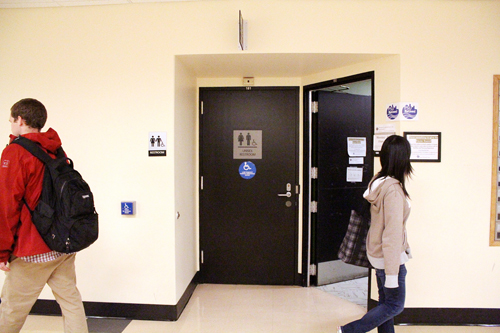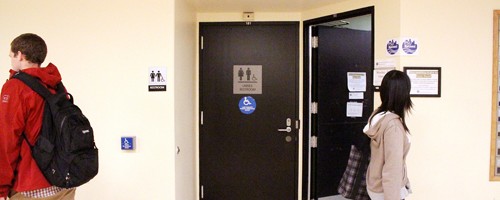The Smith advisory board met last Monday and unanimously approved a resolution to convert one women’s bathroom to a gender-neutral facility. Located on the fourth floor of the Smith Memorial Student Union next to the Queer Resource Center, the restroom will be the first multi-stall, multi-user gender-neutral bathroom on campus. SMSU staff is still working on the timing for the exact date of the conversion.
Becoming gender-neutral

The Smith advisory board met last Monday and unanimously approved a resolution to convert one women’s bathroom to a gender-neutral facility. Located on the fourth floor of the Smith Memorial Student Union next to the Queer Resource Center, the restroom will be the first multi-stall, multi-user gender-neutral bathroom on campus. SMSU staff is still working on the timing for the exact date of the conversion.
Dean of Student Life Michele Toppe explained that the facility is part of Portland State’s goal to create an inclusive environment for all students. Prior to the board’s vote, Toppe presented studies relating to transgendered access at PSU.
Citing a National Association of Student Personnel Administrators research grant proposal that collected information from more than a dozen studies, Toppe explained that for transgendered and gender-variant students, using the restroom is a major source of stress and apprehension. She concluded that there is “broad evidence across the literature” that restroom use is a source of stress for transgendered and gender-variant students. Toppe applauded PSU’s efforts to make the campus more inclusive.
The proposal cited a 2004 article by S.R. Rankin notes that gender-exceptional and gender-variant students are frequently subject to physical and verbal harassment and live in fear of future harassment. The research proposal also cites evidence from the Journal of College Student Development that suggests campus climates are less hospitable for transgender students than their gender-conforming peers.
Another study from the Transgender Law Center titled “Peeing in Peace” explains that “accessing a safe restroom is an everyday challenge for many transgendered and gender non-conforming people.” For a transgender or gender-variant student, “the concern of safety and harassment in restrooms overrides any concern that a student may have about their academics,” according to the study.
PSU is a good location for further studies on transgendered accessibility because of two supporting factors already in place, according to the research proposal. First, PSU’s extended health service package covers all of the medical and psychological needs specific to transgendered students. Secondly, Portland is dense with transgender and gender-variant communities.
The Vanguard asked Director of Campus Public Safety Phillip Zerzan if a communal, gender-neutral bathroom would be less safe than a gendered communal bathroom. Zerzan was unsure because it is unprecedented on campus. “We understand the concept and we’re supportive of it,” Zerzan said. He elaborated that this does “represent a social change, and we don’t know what the results will be. We want it to work and we want to be supportive of it,” he said.
According to the Dean of Student Life website, there are 16 gender-neutral bathrooms on campus, although they are all single-occupancy. Zerzan explained safety concerns associated with these gender-neutral facilities usually involve drug use or other illicit activities due to the privacy of single-occupancy. He said the issues are separate from the gender-neutral status of the restrooms.
Transgender access coordinator at the Queer Resource Center and Women’s Studies senior Kirsten Keith explained the gender-neutral restroom space is more comfortable for transgendered students and provides easier access to restrooms. Keith explained that converting this restroom demonstrates a commitment from PSU to the needs of the transgendered community on campus.
Keith also explained that other schools have multi-stall gender-neutral restrooms, but that they are typically installed in residence halls and not academic buildings. Keith explained that the Young Women’s Christian Association in Portland operates a similarly styled restroom.
Although the research proposal that Toppe cited officially notes that 0.3 percent of PSU’s population identifies as transgendered or gender-variant, Keith explained that likely it’s much higher than that. “It’s hard to survey,” Keith said. “A lot of folks don’t want to identify at Portland State” for fear of backlash and personal fears for their safety.
Keith explained that it can be an uncomfortable topic for many people and that many people do not fully understand the needs or lifestyle of transgendered students. This leads to transgender and gender-variant students not wanting to visibly identify as such.
Keith has been involved in this project for at least two years as it has undergone research and planning. Currently, this is the only restroom planned to be multi-stall gender-neutral on campus. Keith was similarly unsure what the social impact of this restroom would be but predicted that it would be mostly received well by the community.





If this means they will remodel the stalls so that they were like walking into a personal room (a box) to do your duty then sure that would be great! Kinda like this:
http://bit.ly/LafSGT or this http://bit.ly/KZYdSp
But if they are kept in their current state with crack and short walls, then uhh No Thank You!
Those stalls don’t have short walls. They’re tall.
And who cares if they did? It’s not like anyone is going to want to look at you while they’re doing their business.
It’s cool that they are moving to having more access, during many queer oriented events we cover up the bathroom signs on the floor our event is on and it’s fine, I’m surprised it wasn’t mentioned as something that already happens probably once a term and nothing has exploded yet. And every day there are people of a variety of genders going into every bathroom, so it isn’t like it is a binary haven anyway. The language in this article could certainly be more consistent and thoughtful (I.e. The use of the word transgendered).
The hell does it matter what the stalls look like? You terrified of catching a glimpse of junk that’s not yours or something?
You can’t see a damn thing in a public bathroom unless you’re actively trying to look. Just let people shit in peace, goddamn.
Just an FYI: “transgendered” is not a word. “Transgender” is.
Otherwise, all around great news!
I think this is amazing, and PSU is amazing for doing it. I can’t wait to use the gender neutral bathroom.
About damn time!
This is a goddamn joke where are the women of the forth floor suppose to go to the bathroom you are now making a bathroom that will become a sexual play place and leaving the women without a bathroom and this should be against the law.By the way I am transgendered and do not agree with Oregon’s law on bathrooms use. I think bathrooms should be use by what your ID says your gender is. Not just because you think you a female then you can use a women’s bathroom or vis-versa. this is all for that worthless closet on the 4th floor called the QRC which is still literally in a damn closet. I will be waiting to hear about the rapes and violence that will take place in that bathroom as haters will go in there just to harm or threaten people. Sorry PSU will hide the fact that it is happening just like the 3 attacks, and the video recorded death threats that happened to me on this campus. I figure this will be removed by this damn college like everything else I post.
Samantha I can see your point of view and agree with some things you say but you sound irrationally angry. Maybe you should talk to somebody about that or take it up with the state of oregon if you disagree with the laws.
I’m transgender and think these bathroom are a waste of money and a joke. I see no problem in creating a unisex handicap bathroom. Its there for everybody, it serves its purpose, and creates safety. I think these gender neutral bathrooms puts more attention on the problems and not solving them. Everyone will now walk by that bathroom and know its the special bathroom for trannies. Ya, great way to get called out when someone wants privacy. Let’s quit blowing up the issue to astronomical heights and stick with whats simple. Put more unisex bathrooms on campus. There is nothing wrong with them. I’ve never had a problem. Hell I even use the women’s restroom. If the girls’ got a problem, I say stick it up ur a**. My d*** don’t swing towards u hun so quit worrying. There are more important issues then creating special rooms for a dumb reason.
I talked about this on my recent radio broadcast:
http://techdshow.com/2012/06/24/30-aubrey-plazas-eyeballs